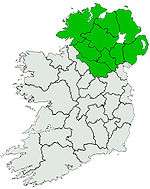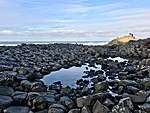Fair Head
Fair Head or Benmore (Irish: An Bhinn Mhór; The Great Cliff) is a 5 kilometre mountain cliff, close to the sea, at the north-eastern corner of County Antrim, Northern Ireland, whose rock face is formed into distinctive vertical columns like organ pipes. Fair Head is regarded as one of the best outdoor rock-climbing locations in Ireland, and its long cliff, up to 100 metres high in places, is considered one of the biggest expanses of climbable rock in the British Isles.[2]
| Fair Head | |
|---|---|
| Irish: An Bhinn Mhór The Great Cliff[1] | |
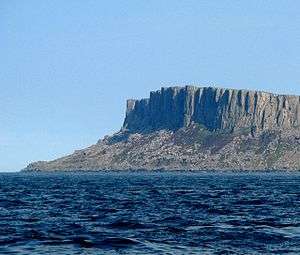 Fair Head's distinctive organ pipe dolerite columns, as taken from the Rathlin Island–Ballycastle ferry | |
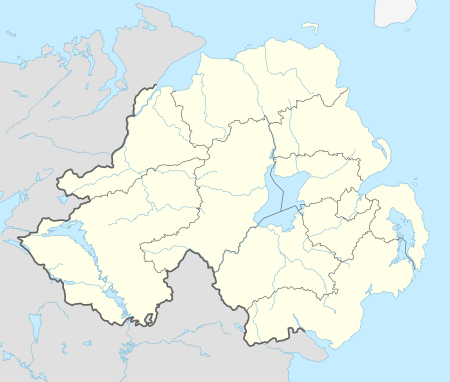 Location of Fair Head in Northern Ireland | |
| Location | County Antrim, Northern Ireland |
| Nearest city | Ballycastle, 3 miles (5km) away |
| Coordinates | 55°13′16″N 6°09′14″W |
| Climbing type | |
| Height | Single pitch climbs of 20–30 meters. Multi pitch climbs of up to 100 meters |
| Pitches | Single pitch and Multi pitch |
| Ratings |
|
| Rock type | Dolerite sill |
| Quantity of rock |
|
| Development | Mountain cliff area; no facilities |
| Cliff aspect | North |
| Elevation | 196 metres at maximum |
| Ownership | Private land but farmers grant access |
| Camping | paid camping nearby; also in Ballycastle |
| Classic climbs |
|
| Website | Climbing.ie Fair Head |
History and setting
Fair Head's distinctive rock formations may be recorded in Ptolemy's Geography (2nd century AD), being described as a point called Ῥοβόγδιον (Robogdion) (cf the Pictish Robogdii tribe) which may refer to Fair Head. The name may derive from the Proto-Celtic root *bogd, "bend".[3]
The headland of Fair Head rises 196 metres above the sea. Wild goats can be seen roaming among the rocks beneath the clifftops, where a walkway called The Grey Man's Path winds around the rugged coastline. From the road, a man-made Iron Age island or crannóg can be seen in the middle of a lake, Lough na Cranagh. The lakes are stocked with trout and can be fished during the summer months. All of the land at Fair Head is private farmland, and not owned by National Trust. Access is by the goodwill of local farm owners. Fair Head is the closest headland to Rathlin Island.
Many famous Irish artists have painted Fair Head, including Maurice Canning Wilks who painted a watercolour from a nearby beach.
Rock climbing
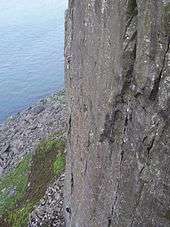
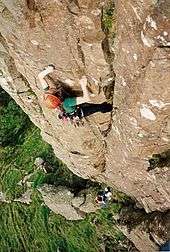
Fair Head is regarded as one of Ireland's best outdoor rock climbing areas, along with the limestone sea-cliff of Ailladie in County Clare.[4] It does not attract a high volume of rock climbers due to its relatively remote location, and the physical strength and unfamiliar climbing techniques it requires of climbers. Its cliffs stretch over 5 km around the headland, rising to a maximum height of over 100m. They are not sea-cliffs but have been described as a mountain crag by the sea, since they tower above an extensive boulder field and their isolation and size gives climbing there a big-wall mountaineering feel.
The cliffs are composed of dolerite, giving a mixture of steep cracked walls, corners, and, in many places, sets of columns reminiscent of organ-pipes. The dolerite sits on top of a bed of chalk which is visible in places.
The cliffs abound in well-protected steep crack climbing, between one and four pitches long. Many of the cracks involve hand-jamming, so some climbers tape their hands to protect the skin from what they term "Fair Head rash". Other climbs involve off-width or full-width chimneying, which is not often encountered in other Irish crags. As with nearly all Irish crags, only traditional protection ("clean climbing") is used. The 2014 Fair Head guidebook, its 6th edition, lists over 430 routes from under grade VS 4c up to E6 6b, but more recent climbing includes routes up to E8 6c.
Climbing history
The first climbs at Fair Head were done in the mid–1960s by some Belfast–based climbers and members of the Dublin–based Spillikin Club. Most of these climbs followed loose and dirty chimneys and are rarely repeated nowadays, but the seed had been planted, and before the end of the sixties development of the crag had started in earnest. However, it was not long before the increasing political violence in the North started making its presence felt; the Fair Head area was generally unaffected, but the development of the crag slowed to a trickle during the early 1970s. However the attractions of Fair Head eventually proved irresistible and development picked up again in the late seventies, led by the husband-and-wife team of Calvin Torrans and Clare Sheridan and a number of other Dublin climbers. This small band devoted themselves to developing Fair Head, founded the Dal Riada Climbing Club (named after the ancient kingdom which included this area), and acquired a climbing hut nearby to accommodate themselves and other visiting climbers. There is still unclimbed rock at Fair Head; opportunities, mainly in the higher grades, are waiting for those who have the talent and dedication.
Climbing layout
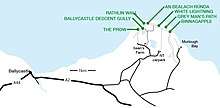
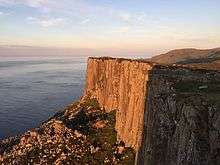
The cliffs are divided into several main sectors. From east to west, these are:[5]
- The Small Crag, a 20m–high sector with 70 climbs stretches for 1 km above a heavily forested hillside; the difficulty of access means that abseiling in is usually required. Together with infestations of midges, this makes the sector unpopular, in spite of the quality of climbing to be had there.
- The Main Crag (including The Prow at its western end), is by far the most important sector. It curves around the headland for 3 km, and contains the longest and best-quality climbs, up to 100m in height. Access is gained mainly by two easy descent gullies near either end of the sector, the Grey Man's Path at the east, and the Ballycastle Gully at the west. The Ballycastle Gully tends to be the more popular descent route for casual visitors, as there is a concentration of easier climbs in the vicinity. Between the two gullies, the starts of climbs can be reached by picking one's way through the boulder field or by doing a usually-vertical abseil of up to 100m.
- Farrangandoo, this popular small sector consists of columns with intervening cracks every 2m or so and contains about 30 single-pitch climbs.
- Marconi's Cove, is about 500m distant from the rest of the crag, and was not discovered until 1988, but contains about 25 good quality single-pitch climbs.
- Complete Scream, is a cliff area with a route nearly 58 metres long at the British grade of E8 6b, which roughly translates to the mid-5.12 range.[6] Complete Scream (E8 6b) was first climbed in 2005 by Ricky Bell. The route was climbed onsight in 2015 by Pete Whittaker, who protected the lower half with skyhooks. In June 2016, U.S. climber Alex Honnold soloed the route, and his ascent was captured on video.[7]
Base camps are usually established near the tops of the descent routes; the walk-ins this far are pleasant and quite short, through the open grazing fields above the crag. However, access to some of the climbs themselves can be quite rough and time-consuming.
Visiting the crag
The Dal Riada Climbing Club formerly had the use of a series of buildings which they operated as climbing huts which they used to accommodate themselves and other visiting climbers, but this ended in 2007 when the last one was repossessed by its owners, the National Trust.[8] The most popular options now are either camping at a nearby campsite operated by a local farmer, or staying at a hostel in Ballycastle town, where there are bars and restaurants.[9]
Climbing bibliography
- Bell, Ricky; Hiller, Craig (2014). Fair Head Rock Climbing Guide Book (6th Edition). Mountaineering Ireland. ISBN 0-902940-21-X.
- Flanagan, David (2014). Rock Climbing in Ireland. Three Rock Books. ISBN 978-0956787422.
- Hunter, Rob (2012). Fairhead Bouldering Guide. Rob and Veronica Hunter. ISBN 978-0957503403.
- Torrans, Calvin; Sheridan, Clare (2002). Fair Head Rock Climbing Guide (1st Edition). Mountaineering Ireland. ISBN 978-0902940185.
See also
| Wikimedia Commons has media related to Category:Fair Head. |
- Ailladie, major rock climbing limestone sea–cliff in County Clare
- Dalkey Quarry, major rock climbing granite quarry in Dublin
References
- "Place Names NI: Fair Head or Benmore, Country Antrim". PlaceNamesNI.org.
- Rob Greenwood (June 2015). "DESTINATION ARTICLE: Fair Head - Northern Ireland". UK Climbing. Retrieved 11 August 2016.
- "Names essay" (PDF). www.romaneranames.uk. Retrieved 8 September 2019.
- "Fair Head, Antrim". Hike & Climb.
- "Fair Head: Layout". Irish Climbing.
- "Alex Honnold Solos The Complete Scream (E8 6b)". Climbing.com. 7 June 2016.
- "Alex Honnold Solos Hard Ireland Route The Complete Scream in Fair Head". Gripped. 9 June 2016.
- "HugeDomains.com - FairHeadClimbers.COM is for sale (Fair Head Climbers)". www.hugedomains.com. Retrieved 13 December 2018.
- "Visiting". fairheadclimbers.com. Retrieved 15 November 2010.
External links
- The Northern Ireland Guide:, Pictures and information on Fair Head and the Crannóg
- Fair Head Climbing Association
- Irish climbing.ie, Fair Head Online Database
- UK climbing.com, Fair Head Online Database
- Introduction of Fair Head Rock Climbing, Climbing Daily TV

